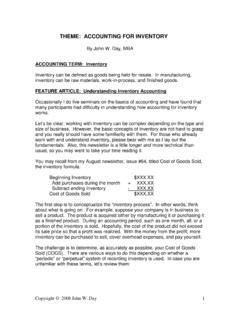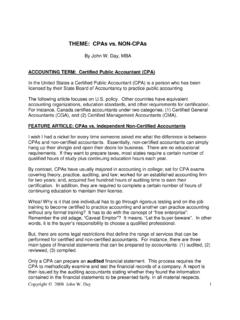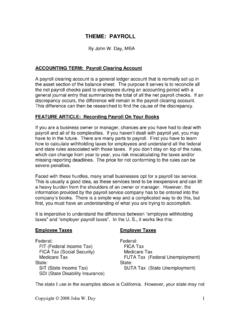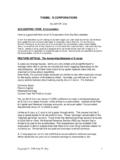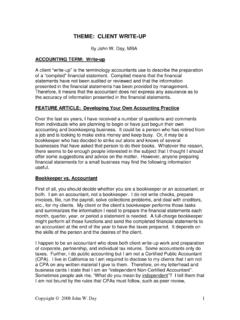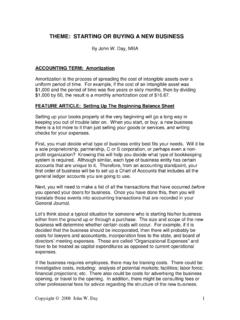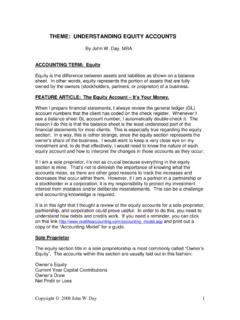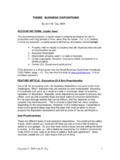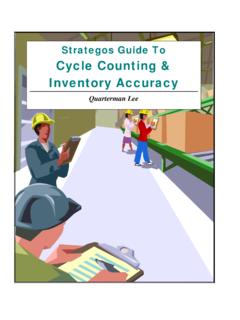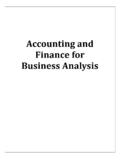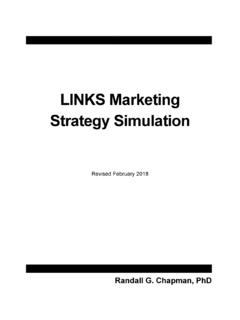Transcription of RLA Article Liquidating a Sole Proprietorship
1 Copyright 2008 John W. Day 1 . THEME: Liquidating a Sole Proprietorship By John W. Day ACCOUNTING TERM: Sole Proprietorship A sole Proprietorship is an unincorporated business with a single owner. It is a pass-through entity in that the profit or losses from the business are reported on the individual s personal Form 1040 tax return. Only the income and expenses are reported on Schedule C. No Balance Sheet is required on the tax return. From a legal standpoint, no differentiation is made between the business entity and the individual. This means that if you get sued over a business transaction, your personal assets are at risk.
2 FEATURE Article : Liquidating A Sole Proprietorship Unfortunately, for some people the moment comes when there is no other reasonable opportunity other than to throw in the proverbial towel and close the sole Proprietorship . This experience may be very different from one person to the next. Perhaps shutting down comes as a great relief from unrelenting pressure. Or, maybe it is a real heartbreaker having to give up the dream of independence and being your own boss. The decision could even come with a sense of failure and financial ruin. Whatever the reason, the books have to be closed, the assets liquidated and the liabilities paid off.
3 Over the years, I have watched a number of clients go through this process. I ve yet to see a disposition that hasn t been difficult for the owner. This is especially true for owners who end up having business debt added to their personal debt. Sometimes, owners have invested their lifetime savings in the business never believing that their dream could turn into a nightmare. You may want to read a short e-book I wrote called Dream or Nightmare: Four Must Do s Before Starting a Small Business . You can find it by clicking this link In the book I try to give the reader a heads up as to the pitfalls of starting a new business without adequate planning.
4 You may be wondering why anyone would simply liquidate the business instead of selling it. Good chance the owner has tried to sell the business but has no takers. It could be that there is no measurable goodwill to sell, or the assets are old and not worth much. More likely, there is a market for the assets but not the business. Disposing of the assets is fairly straightforward. It boils down to establishing the book value (if any) of each asset and then determining if there is a gain or loss on the sale or discard. It might be helpful to read or re-read my newsletter Article Disposing of Assets . Here is the link to my articles page: To get the idea of Liquidating a sole Proprietorship firmly in your head, let s set up a sample balance sheet and systematically dispose each item.
5 Keep in mind that I am referring to taxpayers when tax issues are mentioned. Copyright 2008 John W. Day 2 BALANCE SHEET ASSETS Current Assets: Cash 500 Accounts Receivable 900 Inventory 2,500 Fixed Assets: Furniture & Fixtures 3,700 Office Equipment 4,800 Leasehold Improvements 1,650 Accumulated Depreciation < > Other Assets: Deposits 500 Total Assets: 6,350 ===== LIABILITIES Current Liabilities: Accounts Payable 3,450 Sales Tax Payable 875 Credit Card Payable 5,900 Payroll Taxes Payable 1,750 Long-Term Liabilities: Notes Payable 8,400 Total Liabilities.
6 20,375 OWNER S EQUITY Capital Contributions 3,000 Owner s Draw <1,500> Prior Year Equity <8,675> Net Loss for the year <6,850> Total Owner s Equity <14,025> Total Liabilities & Owner s Equity 6350 ===== Copyright 2008 John W. Day 3 Starting from the top of the balance sheet: Cash: Stick it in your wallet, it s yours! You have already paid taxes on it. DESCRIPTION DEBIT CREDIT Owner s Draw 500 Cash 500 Accounts Receivable: If you are a cash basis taxpayer then you must report as income any cash you receive in the year you receive it.
7 Assuming you received any payments in a year after you closed the business, you will have to report this as miscellaneous self-employment income on your 1040 tax return. If you are an accrual basis taxpayer then don t worry if you receive payment in a later year because you will have already reported the income. DESCRIPTION DEBIT CREDIT Owner s Draw 900 Accounts Receivable 900 Inventory: If you are fortunate enough to sell any remaining inventory before the year closes then that sale is recorded just like any other sale. Cost of goods sold is increased and the inventory asset account is decreased. However, if you are stuck with inventory you cannot sell then you will have to show a write-down of your inventory as a line item in the cost of goods sold section of your P&L Statement.
8 DESCRIPTION DEBIT CREDIT Inventory Write-Down 2,500 Inventory 2,500 Fixed Assets: If all your assets are fully depreciated and not worth anything to anybody then your accumulated depreciation account will equal your fixed assets accounts. A simple reversal is all that is necessary to clear the books: DESCRIPTION DEBIT CREDIT Accumulated Depre 5,000 All Fixed Assets Accts 5,000 If, as in our example, there was a book value of $1,950 remaining and the total assets sold for $2,500 then there will be gain on the sale of $550. Hence, this journal entry: DESCRIPTION DEBIT CREDIT Accumulated Depre 8,200 Cash 2,500 Furniture & Fixtures 3,700 Office Equipment 4,800 Leasehold Improve 1,650 Gain on Sale 550 Copyright 2008 John W.
9 Day 4 You pocket the cash 2,500: DESCRIPTION DEBIT CREDIT Owner s Draw 2,500 Cash 2,500 The only remaining asset is that deposit you have with the landlord. If you get it back you would record it as cash and then take it as another draw: DESCRIPTION DEBIT CREDIT Cash 500 Deposits 500 DESCRIPTION DEBIT CREDIT Owner s Draw 500 Cash 500 Realistically, you would more likely wait until all these transactions related to cash were complete and then use the money to pay off your liabilities. Let s assume you have done that and you actually have $4,400 cash in the bank. The next decision would be to choose which liabilities needed to paid first with your limited amount of cash.
10 Obviously, it would be best to pay off the tax liabilities first since there can be some severe penalties for not paying. Sales tax is $875 and payroll tax is $1,750 for a total of $2,650. This leaves $1,775 to pay toward the remaining liabilities. Good chance you would want to pay vendors who have been loyal to you all these years (like your accountant). DESCRIPTION DEBIT CREDIT Sales Tax Payable 875 Payroll Taxes Payable 1,750 Accounts Payable 1,775 Cash (or Owner s Dr) 4,400 The only items left are: Accounts Payable 1,675 Credit Card Payable 5,900 Notes Payable 8,400 Total Liabilities $15,975 a credit balance In the equity section we started out with a net loss $6,850.
